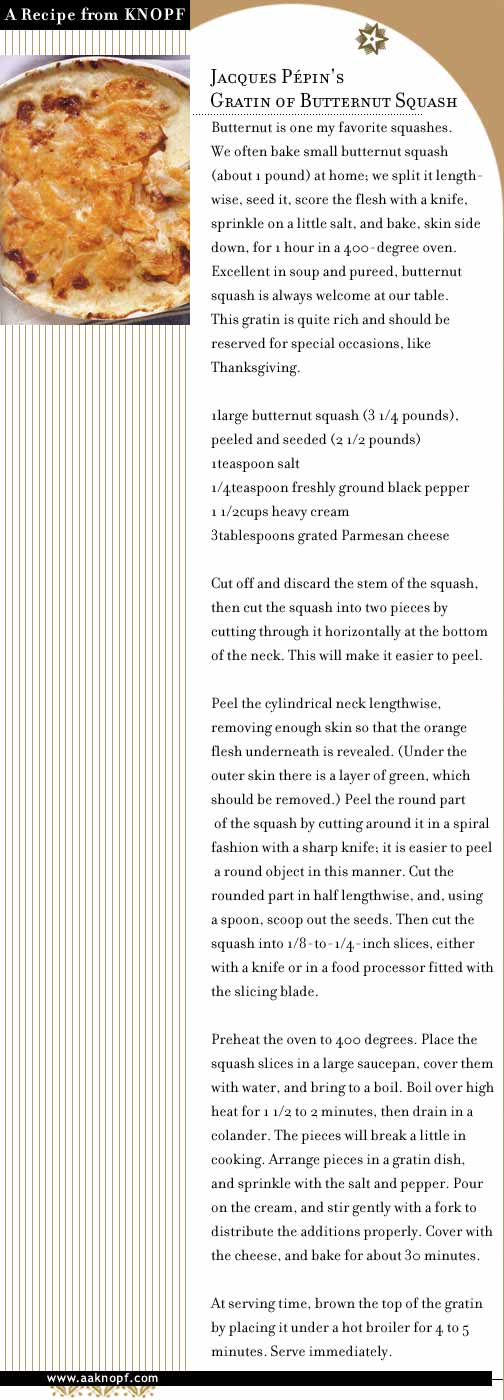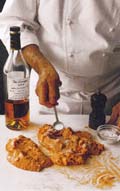| LOCAL LISTINGS FOR JACQUES PÉPIN CELEBRATES
NOTE: Date and time listed is for premiere episode, series will then run consecutively--same day, same time each week for 20 weeks, plus 6 one hour specials to air around specific holidays.
WNET-TV, New York -- Sun 10-14-01, 4:30 pm
KCET-TV, Los Angeles -- Sat 11-10-01, noon
WTTW-TV, Chicago, IL -- Sat 10-6-01, 2 pm
WHYY-TV, Philadelphia, PA -- Sat 10-6 or 13-01, 3 pm (Note: we'll provide
the actual date shortly)
KQED-TV, San Francisco, CA -- Sat 10-13-01, 10:30 am
WGBH-TV, Boston, MA -- Sat 10-6-01, 3:30 pm
KERA-TV, Dallas, TX -- Sat 10-6-01, 5:30 pm
WETA-TV, Washington, DC -- Sat 10-6-01, 6 pm
WTVS-TV, Detroit, MI -- Sat 10-6-01, time TBA
WGTV-TV, Atlanta, GA -- Sat 10-6-01, time TBA
TPT2-TV, Minneapolis/St Paul, MN -- Sat 10-6-01, 4pm
WVIZ-TV, Cleveland, OH-- Sat 10-6-01, 2pm
KAET-TV, Phoenix, AZ -- Sat 10-27-01, 1:30 pm
WQED-TV, Pittsburgh, PA -- Sat 10-13-01, 12:30 pm
WQEX-TV, Pittsburgh, PA -- Sat 10-13-01, 12:30 pm
WMFE-TV, Orlando, FL -- Sat 10-13-01, 4pm
KCPT-TV, Kansas City, MO -- Sat 10-6-01, 10:30 am
KLRN-TV, San Antonio, TX -- Sat 10-20-01, 4:30 pm
WNED-TV, Buffalo, NY -- Sat 10-13-01, noon
WITF-TV, Harrisburg, PA -- Sat 10-6-01, 2 pm
WJCT-TV, Jacksonville, FL -- Sat 10-6-01, 5pm
WXGA-TV, Waycross, GA -- Sat 10-6-01, time TBA
WPTD-TV, Dayton, OH -- Sat 10-6-01, 11:30am
KLRU-TV, Austin, TX -- Sat 10-13-01, 2 pm
WSRE-TV, Pensacola, FL -- Sat 10-6-01, 10:30am
WPNE-TV, Green Bay, WI -- Sat 10-13-01, 2:30 pm
KHET-TV, Honolulu, HI -- Sat 10-6-01, 5 pm
KMEB-TV, Honolulu, HI -- Sat 10-6-01, 5 pm
KSPS-TV, Spokane, WA -- Sat 3-23-01, 10am
WILL-TV, Urbana, IL -- Sun 10-7-01, 4:30 pm
WHA-TV, Madison, WI -- Sat 10-13-01, 2:30 pm
WCLP-TV, Chatsworth, GA -- Sat 10-6-01, time TBA
WNIT-TV, South Bend -- Sat 10-6-01, 11:30am
WVAN-TV, Savannah, GA -- Sat 10-6-01, time TBA
WCES-TV, Augusta, GA -- Sat 10-6-01, time TBA
WEBA-TV, Allendale, GA -- Sat 10-6-01, time TBA
WDCO-TV, Macon, GA -- Sat 10-6-01, time TBA
WHLA-TV, La Crosse, WI -- Sat 10-13-01, 2:30 pm
WHWC-TV, Menomonee, WI -- Sat 10-13-01, 2:30 pm
WJSP-TV, Columbus, GA -- Sat 10-6-01, time TBA
WACS-TV, Dawson, GA -- 10-6-01, time TBA
WHRM-TV, Wausau, WI -- Sat 10-13-01, 2:30 pm
WLEF-TV, Park Falls, WI -- Sat 10-13-01, 2:30 pm
WABW-TV, Albany, GA -- Sat 10-6-01, time TBA
KAKM-TV, Anchorage, AK -- Sat 11-3-01, 7 am
|











